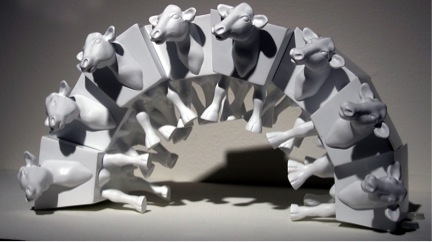
“Stacking Cows” Foam, Resin (2006)
Immediate Response:
The first thing that strikes me about this piece is the arrangement of the cows. Last time I checked, it is not possible to arrange cows up in a vertical arch! However, the particularly polygonal bodies of Van Ness’s cows allows them to fit together like a puzzle as they support each other, seemingly defying the laws of physics as they do so. I also notice that the stark background and colors of the cows themselves are completely blank. There are not even any spots on the cows, which, in my mind, is one of the defining characteristics of a cow.
Objective Description:
This image shows white objects on a white background. The objects appear to be altered forms of cows. There are eight of these cows stacked up against each other, forming a vertical arch. Each cow appears to be exactly the same. The center of their body is a six sided polygonal form with angled edges on the sides. From this body, rather realistic body parts, including the head, legs, tail, and udder extend. The additional body parts do not blend into the polygonal form with any sense of curve. It is as if they were simple mounted on a block in a space that looks appropriate for a cow.
Technical Decisions:
The technical decisions made on this piece make it feel less like actual cows, and more like what they actually are: computerized renders of a creature that were edited and printed in multiples. There is no variation between each cow, which immediately feels unrealistic. Of course, the small size (only a few inches tall) and body shape of the cows contributes to this as well. It is a shape that doesn’t look like could ever be found in the natural world, but rather must have been fabricated using digital software for the sake of convenience in fitting these cows into the arch they form. There is no attempt at hiding this artificiality of these cows, as they are not painted or even placed in a faux-natural setting. They are simply printed in foam core and coated in a plain white resin.
The Work in the World:
This piece actually reminds me a lot of the Rare American Rhinocercow sculpture project I worked on last year. In that project, I made duplicates of a rhinoceros form through a mold-making process and then altered them to take away part of what made them rhinoceros (incidentally making them more like cows in the process) by removing their horns and painting them in a different way. Van Ness does something similar by altering these cows in a way that takes away part of what makes them uniquely cows. Because of his use of digital rendering, he has a more overt way of showing the artificiality of these imaginary creatures than what I did. These feel even more as though they could be marketed and sold as children’s toys, because of their lightweight material and small size, as well as the stacking capabilities.
The Story It Tells:
It seems as though David Van Ness is using these stackable cows to imagine a future where we can modify creatures and objects at will. I think that realistically, they won’t be able to be modified in such a clearly digitized and polygonal way, at least for some time. This works seems like an exaggeration of the genetic engineering that is being experimented with currently. Of course, once we learn more and more about tweaking parts of animal or plants, what exactly is going to stop us from turning things into conveniently stackable polygons, that eschew natural curves and details from straightforward efficiency? What practical use will unique colors and patterns of these creatures serve, when they can more easily just be blank canvases for our creations?
